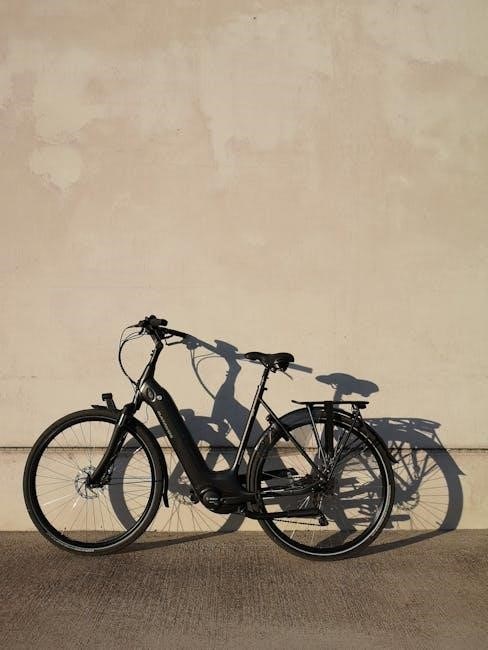Welcome to the Bicycle Frame Size Guide! This guide helps you find the perfect bike fit for comfort and performance. Learn how to measure, choose, and understand frame sizes for an optimal riding experience.
Importance of Proper Frame Size
Proper bicycle frame size is crucial for a comfortable, efficient, and safe riding experience. A well-fitted frame ensures optimal control, reduces the risk of discomfort or injury, and maximizes performance. Riding a bike that is too small or too large can lead to poor posture, strain on joints, and decreased stability. The right frame size aligns your body naturally with the bike, allowing for better energy transfer and maneuverability. Whether you’re a casual rider or an avid cyclist, selecting the correct frame size is essential for enjoying your time on the bike and achieving your riding goals.

Overview of the Guide
This guide provides a comprehensive approach to understanding bicycle frame sizing. It covers essential measurements, such as height, inseam, and reach, and explains how to use bike size charts effectively. The guide also explores the differences between bike types, including road, mountain, and hybrid bikes, and offers tips for testing and adjusting your fit. Whether you’re a novice or experienced rider, this guide equips you with the knowledge to select the perfect frame size for comfort, efficiency, and performance. Follow along to ensure your next bike fits you perfectly!

Key Measurements for Determining Frame Size
Key measurements include height, inseam, reach, and arm length. These factors help determine the ideal frame size for a comfortable and efficient riding experience.
Height and Inseam
Your height and inseam are fundamental for determining the right bike frame size. Height helps estimate standover clearance, while inseam, measured from the floor to the crotch, indicates the ideal frame size. Taller riders typically require larger frames, while shorter riders need smaller ones. For accurate sizing, use a bike size chart specific to your bike type, as measurements vary between road, mountain, and hybrid bikes. Ensure your inseam allows a 1-2 inch clearance for road bikes and 2-4 inches for mountain bikes. This ensures comfort, safety, and optimal performance while riding.
Reach and Arm Length
Reach and arm length are critical for determining handlebar height and comfort. Reach refers to the horizontal distance from the saddle to the handlebars, while arm length influences how you grip the bars. Proper reach ensures your arms are slightly bent, allowing control and comfort. Measure your arm span (fingertip to fingertip) and compare it to the bike’s reach measurements. For road bikes, a longer reach suits taller riders, while shorter reaches are better for smaller frames. Adjusting stem length and handlebar height can fine-tune your fit, ensuring optimal comfort and control during rides.

Understanding Bicycle Frame Size
Understanding bicycle frame size is essential for a proper fit. It measures from the crank axle to the seat tube top, ensuring comfort and optimal performance.
What is Frame Size?
Frame size is the distance from the center of the crank axle to the top of the seat tube, measured in centimeters or inches. It determines the bike’s fit and is crucial for comfort and performance. The size is often printed on the seat tube or below the top tube. Manufacturers may vary in sizing, so consulting their charts is essential. Proper frame size ensures optimal riding posture and efficiency, making it vital for cyclists of all levels to achieve a best riding experience.
How Frame Size is Measured

Frame size is measured as the distance from the center of the crank axle to the top of the seat tube. This measurement is typically taken in centimeters or inches and is printed on the seat tube or below the top tube. To measure accurately, place the bike on a level surface and use a tape measure or specialized tool. Ensure the measurement is straight and precise. Some manufacturers may have slight variations, so always refer to their specific sizing charts for consistency and accuracy in determining the correct frame size.
Difference Between Nominal and Actual Frame Size
Nominal frame size refers to the size labeled by the manufacturer, often based on standard measurements like seat tube length. Actual frame size is the precise measurement from the crank axle to the seat tube top. While nominal size provides a general guide, actual size can vary slightly due to frame geometry and design. Always check the actual measurements against the manufacturer’s size chart for accuracy. This ensures the best fit, as nominal sizes may differ between brands or models due to varying frame geometries and materials used in construction.
Why Frame Size Matters
Frame size is critical for a comfortable and safe riding experience. A bike that is too small or too large can lead to discomfort, poor control, and even injury. Proper frame size ensures optimal body positioning, reducing strain on your back, neck, and joints. It also enhances performance by allowing efficient pedaling and handling. Incorrect sizing can result in a bike that is difficult to maneuver or causes fatigue. The right frame size maximizes comfort, control, and efficiency, making every ride enjoyable and effective. Always prioritize accurate measurements for the best fit.
How to Measure Your Body for a Bicycle Frame
Measuring your height, inseam, reach, and arm length is essential for determining the right bicycle frame size. Use a flexible tape measure for accurate results.
Measuring Your Height
Measuring your height is a crucial step in determining the right bicycle frame size. Stand barefoot with your back straight against a wall, ensuring the floor is level. Use a flexible tape measure or a height gauge to record your height in inches or centimeters. This measurement helps estimate your standover height and frame size compatibility. For accuracy, ensure the tape measure is parallel to the floor and touches the top of your head. Your height is a key factor in selecting a bike that matches your body proportions and riding style; Always refer to a bike size chart after measuring.
Measuring Your Inseam
Measuring your inseam is essential for determining the correct bicycle frame size. Stand barefoot with your back against a wall, holding a sturdy book or clipboard flat against your groin. Ensure the object is level and touches the wall. Measure the distance from the floor to the top of the object using a tape measure. This measurement, in inches or centimeters, represents your inseam. For accuracy, wear cycling shoes and take multiple measurements, then average them. Your inseam helps calculate standover height and frame size, ensuring proper fit and comfort while riding.
Measuring Your Reach
To measure your reach, stand upright and extend your arms forward at shoulder height. Use a flexible tape measure or a ruler to measure the distance from the center of your chest to the tip of your middle finger. This measurement helps determine the ideal handlebar reach for your bike, ensuring comfort and control while riding. Proper reach alignment is crucial for maintaining an ergonomic position and preventing discomfort or strain during long rides.
Measuring Your Arm Length
Arm length is measured from the center of your neck to the tip of your middle finger, with your arm relaxed by your side. This measurement helps determine the optimal handlebar reach for your bike, ensuring comfort and control while riding. To measure accurately, stand upright and use a flexible tape measure or ask someone to assist for precision. Proper arm length alignment is essential for maintaining an ergonomic riding position and preventing discomfort or strain on long rides.

Using a Bike Size Chart
A bike size chart matches your height and inseam to the ideal frame size, ensuring a proper fit for comfort and performance. Always check the manufacturer’s chart for accuracy.

What is a Bike Size Chart?
A bike size chart is a tool that helps determine the ideal frame size based on a rider’s height and inseam. It provides a reference guide to match body measurements to bike frames, ensuring proper fit and comfort. Most charts vary by bike type, such as road, mountain, or hybrid bikes, as each has distinct geometry. By using height and inseam, the chart recommends the most suitable frame size for optimal performance. While some charts may rely solely on height, combining it with inseam ensures greater accuracy. Always consult the manufacturer’s specific chart for precise sizing.
How to Use a Bike Size Chart

Using a bike size chart is straightforward. Start by measuring your height and inseam accurately. Locate the chart specific to the type of bike you’re interested in, such as road, mountain, or hybrid. Match your measurements to the corresponding frame size. Pay attention to the units (centimeters or inches) and note that charts may vary between manufacturers. For precise fit, consult the chart provided by the bike’s manufacturer, as sizing can differ slightly. If unsure, consider visiting a professional fitter to ensure the best fit for comfort and performance.
Limitations of Bike Size Charts
While bike size charts are helpful, they have limitations. They provide a general guide and may not account for personal fit preferences or body proportions. Charts can vary between manufacturers, as sizing standards differ. Additionally, they often don’t consider riding style or terrain, which can affect the ideal frame size. For precise fit, charts should be used as a starting point, and further adjustments may be needed. Always test a bike if possible, and consult a professional fitter for optimal comfort and performance, especially for complex needs or unique body types.
Different Types of Bikes and Their Sizing
From road bikes to mountain and hybrid models, each type has unique sizing requirements. Understanding these differences ensures the best fit for your riding style and needs.
Road Bikes
Road bikes are designed for speed and efficiency on paved surfaces. Their frame sizing is typically determined by height and inseam measurements. A common recommendation is to use a bike size chart specific to the manufacturer, as sizing can vary. For road bikes, the standover height is a key measurement, ensuring there’s enough clearance for safety. Fit is crucial, with factors like stem length and handlebar reach affecting comfort. Generally, road bikes come in frame sizes ranging from 47cm to 62cm. Consulting a size chart or a professional fitter is advisable to ensure the best fit for optimal performance and comfort during long rides.
Mountain Bikes
Mountain bikes are designed for off-road adventures, with frame sizing based on height and inseam. Standover height is crucial for safety and comfort, ensuring enough clearance. Unlike road bikes, mountain bike sizing varies by geometry, such as trail, enduro, or cross-country. Handlebar width and stem length also impact fit. Generally, frame sizes range from 13 to 23 inches, depending on the rider’s height. Consulting a size chart or professional fitter is recommended to ensure proper fit, as bike geometry differences can affect handling and performance on varying terrain.
Hybrid and Gravel Bikes
Hybrid and gravel bikes offer versatility, blending elements of road and mountain bikes. Frame sizing for hybrids is based on height and inseam, ensuring a comfortable upright riding position. Gravel bikes, designed for mixed terrain, prioritize stability and control, with frame sizes often similar to road bikes but with longer wheelbases. Both types emphasize practicality, with sizing charts typically catering to a wide range of riders. Proper fit ensures efficiency on both paved and unpaved paths, making these bikes ideal for commuting and adventure. Always consult a size chart or professional to find your perfect fit.
Kids’ Bikes
Kids’ bikes are sized differently than adult bikes, typically by wheel size rather than frame size. Common sizes include 12″, 16″, 20″, and 24″ wheels, corresponding to the child’s age and height. For example, a 12″ bike suits children aged 3-5 years, while a 24″ bike is for older kids, around 9-12 years. Standover height is crucial for safety, ensuring the child can dismount easily. Frame size charts for kids often align with these wheel sizes, but it’s important to consider the child’s inseam and overall fit. Test riding, when possible, ensures comfort and proper sizing. Adjustable components can accommodate growth, making the bike a lasting investment.

Advanced Topics in Frame Sizing
Explore advanced frame sizing concepts, including frame geometry, standover height, and material impact. Understanding these elements ensures optimal fit, performance, and safety for all riders.
Frame Geometry Explained
Frame geometry refers to the measurements and angles of a bike’s frame, impacting its handling and performance. Key elements include top tube length, head tube angle, seat tube angle, and wheelbase. These measurements determine how a bike maneuvers, with steeper angles offering agility and slacker angles providing stability. For example, road bikes often have steeper head tube angles for aerodynamics, while mountain bikes feature slacker angles for better control on rough terrain. Understanding frame geometry helps riders choose bikes suited to their riding style, ensuring optimal comfort, efficiency, and performance. Proper geometry alignment is crucial for a responsive and enjoyable ride.
Understanding Standover Height
Standover height is the distance between the top of the bike frame and the rider’s inseam when standing over the bike. It ensures comfort and safety by providing clearance. A general rule is to have 1-2 inches of space for road bikes and slightly more for mountain bikes. Proper standover height prevents discomfort and injury, allowing for better control and maneuverability. Measuring this by standing over the bike with feet shoulder-width apart helps determine the right fit, ensuring the bike matches the rider’s body proportions for optimal performance and safety.
Importance of Frame Material
Frame material significantly impacts a bike’s performance, comfort, and durability. Common materials include aluminum, carbon fiber, steel, and titanium. Aluminum frames are durable and affordable, while carbon fiber offers lightweight construction and shock absorption. Steel frames provide a smooth ride and are often used in custom builds, and titanium combines strength with a lightweight feel. Each material affects the bike’s responsiveness, weight, and longevity, making it essential to choose based on riding style, budget, and terrain. The right material ensures optimal performance and enhances the overall cycling experience.
Finalizing Your Frame Size

Once measurements and charts are considered, test the bike to ensure comfort and control. Consult a professional if unsure, as proper fit is key to optimal performance and safety.
How to Test a Bike for Fit
Testing a bike for fit involves checking standover height, saddle height, and reach. Standover height ensures 1-2 inches of clearance for safety. Saddle height should allow a slight bend in the knee when the pedal is at its lowest point. Reach should feel comfortable, with a slight bend in the elbows. Take a short ride to assess handling and comfort. If adjustments are needed, fine-tune the saddle position, handlebar height, or stem length. A professional bike fitting can also provide precise adjustments for optimal performance and comfort.
Common Mistakes to Avoid
When choosing a bike frame size, common mistakes include relying solely on height, ignoring inseam measurements, and not considering reach and arm length. Overcomplicating the process by focusing too much on manufacturer variations can also lead to poor fit. Additionally, some riders neglect to test the bike thoroughly, missing issues like standover height or saddle comfort. To avoid these errors, use a size chart specific to the bike type and manufacturer, and always take a test ride. Consulting a professional can also help ensure the best fit for comfort and performance.
When to Consult a Professional
Consulting a professional is advisable when you’re unsure about your measurements or need a customized fit. Experts can assess your body proportions, riding style, and bike type to recommend the ideal frame size. They often use advanced tools like bike fitting systems to ensure optimal comfort and performance. If you’re investing in a high-end or custom bike, a professional fitting is crucial. Additionally, riders with unique body proportions or specific needs, such as ergonomic adjustments, should seek professional guidance. Their expertise ensures a perfect fit, enhancing your riding experience and preventing discomfort or injury.
Choosing the right bike frame size is crucial for comfort, performance, and injury prevention. This guide provides essential measurements and expert advice to help you find your perfect fit. Happy cycling!
Proper bike frame size ensures comfort, efficiency, and safety. Key measurements include height, inseam, reach, and arm length. Use bike size charts for guidance, but consider differences in bike types (e.g., road, mountain, hybrid). Frame geometry and material also impact fit. Test bikes when possible, and consult professionals for complex sizing needs. Remember, the right frame size enhances performance and reduces injury risk. Always prioritize a comfortable fit tailored to your riding style and body proportions.
Final Tips for Choosing the Right Frame Size
When selecting the ideal bike frame size, prioritize a combination of accurate body measurements and bike-specific sizing charts. Ensure your height, inseam, and reach align with the manufacturer’s guidelines, as these vary by bike type (e.g., road, mountain). Consider frame geometry and material for optimal comfort and performance. Always test ride bikes when possible to confirm fit, and avoid common mistakes like relying solely on height. If unsure, consult a professional fitter to tailor the frame size to your unique needs and riding style for the best experience.



